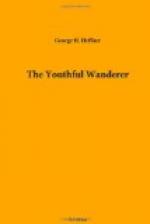This chapel contains many royal tombs. Among others are the altar-tomb, with effigy of the mother of Lord Darnley, husband of Mary, Queen of Scots; tomb, with effigy of Queen Elizabeth (her sister, Mary, being buried in the same grave); and the tomb, with a fine effigy of Mary, Queen of Scots, erected by her son, King James IV., of Scotland, (being James I. of England). The face of this image is very beautiful, and generally recognized as a genuine likeness of the Queen. Oliver Cromwell’s bones were speedily ejected from this chapel at the Restoration.
In the E. aisle of the North Transept is a remarkable monument to Mr. and Mrs. Nightingale. Death represented in the ghastly form of a sheeted skeleton has just issued from a dark aperture in the lower part of the monument, and aims his dart at the sick lady who has sunk affrighted into her husband’s arms. “This dying woman,” says Cunningham, “would do honor to any artist.”
In another part of the church, we found a fine monument to “Major John Andre, who raised by his merit, at an early period of life, to the rank of Adj. General of the British forces in America, and employed in an important but hazardous enterprise, fell a sacrifice to his zeal and his king and country on the 2nd of October, A.D., 1780, aged 29 years, universally beloved and esteemed. His gracious sovereign, King George the Third, has caused this monument to be erected. The remains of Major John Andre were on the 10th of August, 1821, removed from Tappan by James Buchanan, Esq., his Majesty’s consul at New York, under instruction from his Royal Highness, the Duke of York, and with the permission of Dean and Chapter finally deposited in a grave contiguous to this monument on the 28th of November, 1821.”
There are altogether between twenty-five and thirty kings and queens buried in this Abbey, besides a host of England’s most famous statesmen, soldiers, poets and other eminent persons that have flourished within the last five or six centuries, a mere catalogue of whose names would fill whole pages.
It seems odd enough to an American to find large graveyards in the interior of churches and cathedrals, and to see monuments, tombs and altar-tombs, with the effigies of persons lying in state having all kinds of animals (their crests) lying at their feet; but a day in Westminster will accustom one to such scenes.
Arms and Crests.
In England, it is very common to place the crests of the nobility with their effigies upon their tombs. Thus Mary, Queen of Scots, has the lion lying at her feet, and in St. Mary’s, at Warwick, I learned that the Muzzled Bear is the Earl of Warwick’s crest, while the Marquis of Northampton has the Black Swan, and Richard Beauchamp the Bear and Griffin. Even literary characters were not without them, Shakespeare for example, had adopted the Falcon rising argent, supporting a spear, in pale.
Sunday in London.




